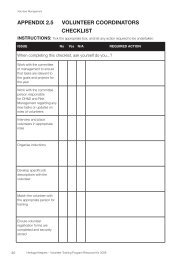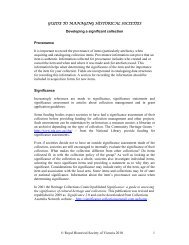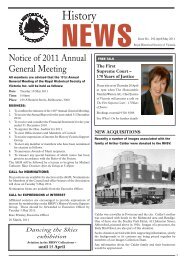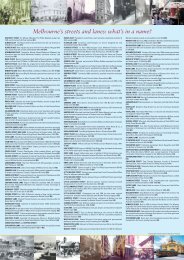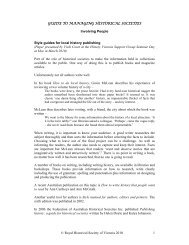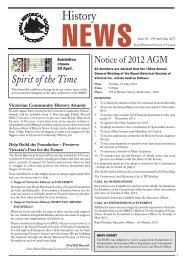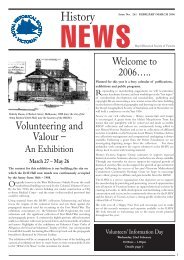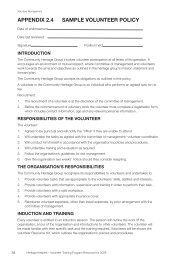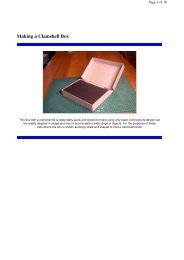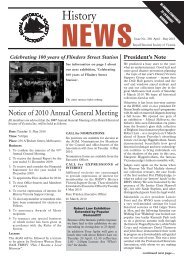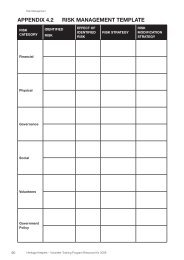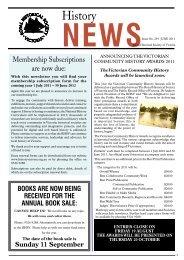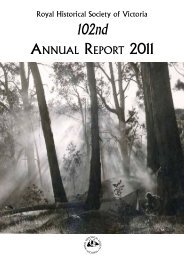Victorian Local History Database - Royal Historical Society of Victoria
Victorian Local History Database - Royal Historical Society of Victoria
Victorian Local History Database - Royal Historical Society of Victoria
Create successful ePaper yourself
Turn your PDF publications into a flip-book with our unique Google optimized e-Paper software.
<strong><strong>Victoria</strong>n</strong> <strong>Local</strong> <strong>History</strong> <strong>Database</strong><br />
Recognising the costs involved in publishing databases on the Internet, Arts <strong>Victoria</strong> provided<br />
funding for the RHSV to operate a server to publish a variety <strong>of</strong> databases including a regional<br />
database containing records from societies in the state.<br />
Advantages <strong>of</strong> involvement in <strong><strong>Victoria</strong>n</strong> <strong>Local</strong> <strong>History</strong> <strong>Database</strong>:<br />
Societies not involved in existing regional database projects can now have their records<br />
included in a state-wide local history database<br />
Regional Internet databases promote the organisations contributing records to the database<br />
Collections in historical societies form part <strong>of</strong> the Distributed National Collection. Participation<br />
in regional databases promotes the important and <strong>of</strong>ten unique items in collections held by<br />
societies<br />
Regional Internet databases allow researchers from anywhere in the world to locate material<br />
in collections<br />
Using regional databases can allow researchers to follow new threads <strong>of</strong> research in<br />
collections they may not have originally considered researching<br />
The <strong><strong>Victoria</strong>n</strong> local <strong>History</strong> <strong>Database</strong> is a regional database containing cataloguing records from<br />
participating societies affiliated with the RHSV. A selection <strong>of</strong> fields describing each item will be<br />
used. The records in the <strong><strong>Victoria</strong>n</strong> <strong>Local</strong> <strong>History</strong> <strong>Database</strong> are stored on the server at the RHSV.<br />
Societies involved in the project export their records with the required fields and send them to me<br />
to be imported into the regional database on the server. Societies do not need to be connected to<br />
the Internet to be involved.<br />
Although the database used in this project is DB/TextWorks, records from other databases and<br />
catalogues such as File Maker Pro, Access and Excel can be included provided that the records<br />
can be exported as comma delimited files. Field names <strong>of</strong> exported records must be identical to<br />
the field names in the <strong><strong>Victoria</strong>n</strong> <strong>Local</strong> <strong>History</strong> <strong>Database</strong>.<br />
Field names in the <strong><strong>Victoria</strong>n</strong> <strong>Local</strong> <strong>History</strong> <strong>Database</strong>:<br />
* Registration Number – a unique number for each item in the database eg B125<br />
* Museum Code – can be a National Union Catalogue Code (if the organisation has one) eg<br />
VFHS - if not, contact me to organise a code for your organisation.<br />
* Object Name - As this is a database <strong>of</strong> information items, Object Name refers to the physical<br />
item catalogued - Book, Article, Photograph, Document, Map, Videotape, Audiotape, Ephemera,<br />
Micr<strong>of</strong>orm, Pamphlet, Periodical, Newsletter, CD, CD-ROM, DVD, Slide, Movie film, Illustration,<br />
Correspondence<br />
* Title – If an item such as a photograph does not have a title, create one – a main subject<br />
heading can be useful<br />
Author – surname first, then given name<br />
Photographer – surname first, then given name (In books, only use this field if one (or two)<br />
photographs took all the photos in the book)<br />
Illustrator – surname first, then given name (In books, only use this field if one (or two) artists<br />
illustrated the book)<br />
Classification – Classification field in this database is not the same as the Classification field in<br />
the Museums Data Structure - there is no need for primary and secondary headings in this<br />
database. Classification may be a number such as a Dewey number used in libraries or another<br />
1
number devised to represent subject groupings eg 13.C.1 or a subject heading in a vertical file eg<br />
Churches<br />
* Subjects – Names <strong>of</strong> people, places, organisations, buildings and objects. For consistency in<br />
the use <strong>of</strong> subject terms use a thesaurus such as the <strong><strong>Victoria</strong>n</strong> <strong>Local</strong> <strong>History</strong> Thesaurus or<br />
Australian Pictorial Thesaurus and Authority Files (lists <strong>of</strong> names <strong>of</strong> people, places etc used in the<br />
database)<br />
* Brief Description – A brief description describing the content <strong>of</strong> the item. It is also useful to a<br />
note if a book has photographs, index, bibliography, list <strong>of</strong> mayors etc<br />
Date Made – Date an item was published or a photograph taken eg 1972<br />
Place – Place where an item was published or a photograph taken eg Melbourne<br />
Publisher – name <strong>of</strong> the publisher <strong>of</strong> a book or other publication eg Rigby<br />
Size – Size will be number <strong>of</strong> pages for books eg 122p or cm for photographs 12 cm x 8 cm. For<br />
tapes, size may be number <strong>of</strong> minutes <strong>of</strong> playing time, if known<br />
Restrictions – Restrictions field is only used if the copyright for a photograph for example<br />
belongs to another organisation or person or there is a restriction placed by the donor on access<br />
to an item (For example: This photograph is not available for copying without permission <strong>of</strong> Yarra<br />
Press)<br />
Address – (Address is useful when the full address <strong>of</strong> a building in a photograph or real estate<br />
leaflet for example is known, then it can be entered in this field in the following format - suburb or<br />
town, street, number for example: Bentleigh, Smythe Street, 22)<br />
Source – (Source is used when cataloguing articles from books or newspapers for entering<br />
information about the original item - for example: Moe News, 22 January 1952, p1. When using<br />
the Source field do not use fields such as Date Made, Publisher, Place etc.)<br />
(Most <strong>of</strong> the above fields (except for Address and Source) are included in the Museums Datastructure<br />
though the field labels in the report forms in the database in some cases will be different<br />
from the field names in the structure.)<br />
Societies will also find it useful to include a field ‘Date entry altered’ with an automatic date (for<br />
DB/TextWorks users) as it will help keeping track <strong>of</strong> altered records and new records to be sent in<br />
the next batch <strong>of</strong> records to be uploaded.<br />
*Compulsory fields in the database are Registration Number, Museum Code, Title, Object Name,<br />
Subjects and Brief Description. Use other fields as required.<br />
Examples <strong>of</strong> possible use <strong>of</strong> fields in entries:<br />
Books – Registration Number, Museum Code, Object Name, Title, Author, Brief Description,<br />
Subjects, Classification, Place, Publisher, Date Made, Size<br />
For example:<br />
Registration Number: B042<br />
Museum Code: VBHS<br />
Object Name: Book<br />
Title: Fernshaw the forgotten village<br />
Author: Mitchell, Alma<br />
Brief description: The story <strong>of</strong> the village <strong>of</strong> Fernshaw from 1864-1890 and <strong>of</strong> Fernshaw Park. List <strong>of</strong><br />
residents <strong>of</strong> Fernshaw and district, Fernshaww subdivision, important dates in the history <strong>of</strong> Fernshaw.<br />
Photographs, index. Bibliography.<br />
Subjects: Fernshaw; Fernshaw Park; Parks and reserves<br />
2
Classification: 13.D<br />
Place: Healesville<br />
Publisher: Healesville <strong>Historical</strong> <strong>Society</strong><br />
Date Made: 2001<br />
Size: 112p<br />
Photographs – Registration Number, Museum Code, Object Name, Title, Brief Description,<br />
Photographer, Subjects, Place, Date Made, Size<br />
For example:<br />
Registration Number: P220<br />
Museum Code: VBHS<br />
Object Name: Photograph<br />
Title: Junior school playground<br />
Brief Description: Coloured photograph <strong>of</strong> climbing frame in the junior school playground at Bayswater West<br />
Primary School.<br />
Subjects: Bayswater West Primary School; Schools; Bayswater; Playground equipment<br />
Photographer: Court, Vicki<br />
Place: Bayswater<br />
Date Made: 2001<br />
Size: 10 cm x 8 cm<br />
Maps – Registration Number, Museum Code, Object Name, Title, Brief Description, Subjects,<br />
Date Made, Size<br />
For example:<br />
Registration Number:<br />
Museum Code: VBHS<br />
Object Name: Map<br />
Title: Dandenong Creek<br />
Brief Description: Map showing the course <strong>of</strong> the Dandenong Creek as it flows through Wantirna and<br />
Bayswater before part <strong>of</strong> the creek was diverted into pipes underground.<br />
Subjects: Dandenong Creek; Bayswater; Wantirna<br />
Date Made: 1931<br />
Size: 40 cm x 35 cm<br />
Audiotapes – Registration Number, Museum Code, Object Name, Title, Brief Description,<br />
Subjects, Date Made, Size<br />
For example:<br />
Registration Number: B431<br />
Museum Code: VBHS<br />
Object Name: Audiotape<br />
Title: Laundry days <strong>of</strong> old<br />
Brief Description: Interview with Mavis Brown <strong>of</strong> Ferntree Gully regarding the method <strong>of</strong> laundering clothes<br />
in the 1920s. Interview conducted by Jenny Smith.<br />
Subjects: Brown, Mavis; Washing clothes<br />
Date Made: 1991<br />
Size: 14 min<br />
Vertical File – Registration Number, Museum Code, Object Name, Title, Brief Description,<br />
Subjects, Author, Classification, Source<br />
For example:<br />
Registration: V542<br />
Museum Code: VBS<br />
Object name: Article<br />
Title: Family ties to tragic past<br />
Brief description: Attempts to discover information about a family member killed in an accident at Boronia<br />
Level Crossing in April 1926<br />
Subjects: Barr, Charles; Boronia Railway Crossing; Railways; Boronia<br />
Author: Hahn, Maree<br />
Classification: Boronia Railway Crossing<br />
Source: Boronia and The Basin Community News, May 2004, p8<br />
3
For further information about this project contact the <strong>Royal</strong> <strong>Historical</strong> <strong>Society</strong> <strong>of</strong> <strong>Victoria</strong> –<br />
<strong>of</strong>fice@historyvictoria.org.au<br />
4



